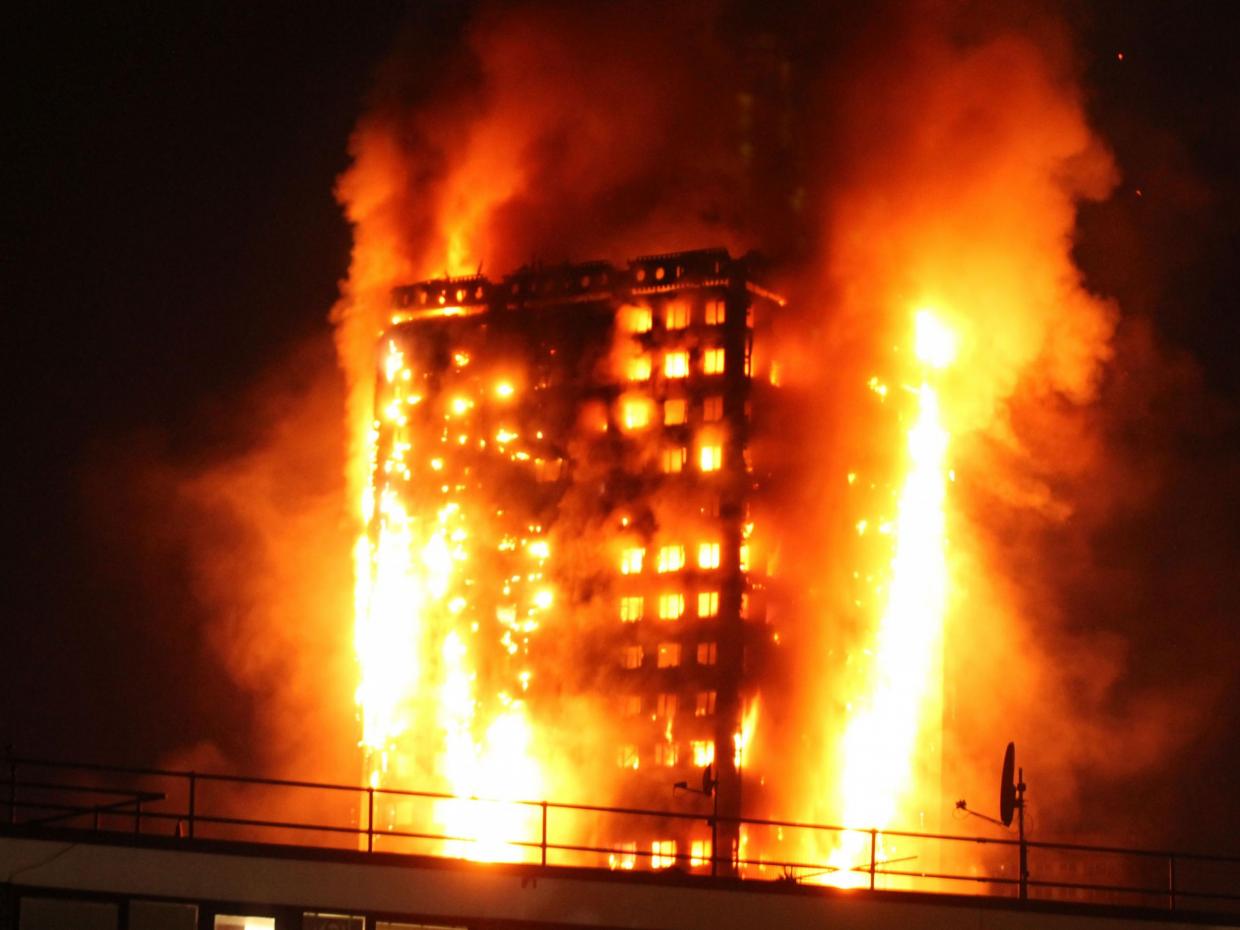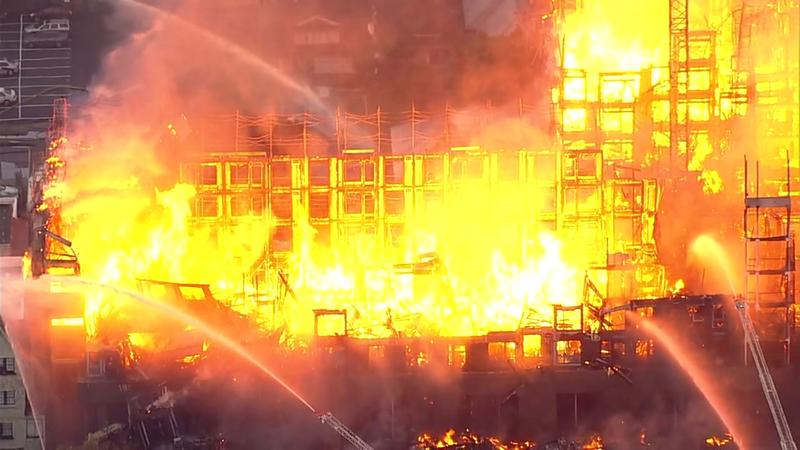
London: Grenfell tower in flames

Oakland CA: Seven story building under construction in flames

Ashmont, MA: Six story building under construction in flames

Somerville, MA: New five story stick-built firetrap
Why, in the 21st century, are we allowing builders to construct brand-new multi-story firetraps?
We know that wood burns. We know how to build with concrete and steel — for years, it seemed that multi-story/multi-tenant construction was built ONLY using fire resistant material.
I understand that sprinkler systems help. I also know that sprinkler systems fail. Fire doors help — fire doors get removed or get propped open.
This strikes me as emblematic of failing government. Surely one of the most important responsibilities of local government is to ensure that our homes do not kill us. We have building codes. We have building inspectors.
I understand that a rehab or condo-conversion of an existing — especially historical — structure might demand compromises in order to preserve the architectural integrity of a 150 year old frame structure.
The buildings that burned in Oakland and Ashmont were brand-new multi-story buildings constructed from WOOD! The “luxury apartments” pictured above in Ball Square are constructed from wood — seriously, there are elevator shafts built from concrete, and perhaps concrete floors (I don’t remember). Everything else is wood. Thousands of square feet of two-by-fours and plywood. Literally tinder.
There is no excuse for building brand-new multistory firetraps like these.
Building multi-story firetraps with wood is pre-meditated murder. All guilty parties should be prosecuted under law.
I certainly hope building codes are enforced, but many homes are built with wood and do fine. Not sure I’m ready to ban that entirely, and not sure why single vs. multi-family is a relevant difference.
” not sure why single vs. multi-family is a relevant difference.”
Christopher, LOOK at the pictures for crying out loud. When a single-family wood-frame dwelling catches fire, it does not endanger dozens or hundreds of families living in the same building.
Suppose you are living in the top-floor corner apartment of the bottom picture of that new building in Somerville (in Ball Square). I’ll tell you the relevance: if somebody on the first floor tosses their cigarette in their wastebasket (improper disposal of smoking materials is a major cause of residential fires), your new luxury home will burn. Your family and pets will be at risk. THAT is why the difference between single vs multi-family is a relevant difference. I have a great deal of control over what does and does not happen in my home. I have NO control over the behavior of other residents in my building.
I’m not proposing to ban wood-frame structures. I am instead proposing that the use of wood-frame construction be limited to MUCH smaller structures than those highlighted above.
OK, yes of course regarding how more people could be impacted. I guess I was focusing on how wood for a larger structure would somehow be inherently more flammable than the same wood used for a smaller structure, which is sounded like you were arguing.
Repealing common sense public policy safety regulations for greed is madness
Let’s be careful. Englands Grenfell Tower, which you cite, was concrete.. It was 22 stories & 200 feet high.. I don’t think you could get 22 stories out of wood alone. 80 feet, about six or seven stories, is about as high as you can get with wood, if I recall correctly. Anything above that and the lower floors simply can’t handle the weight.
Grenfell was designed and built in the 70’s, had no sprinklers, one stairwell (in which large items were stored, a huge no-no) and an exterior cladding added in a poorly thought-out and possibly corrupt ‘renovation.’
Sprinklers very rarely fail. The moving components of a sprinkler system, the heads, have a failure rate of something like 1 in 16 million. Sprinklers have been an epic success in the life-saving business.
We also have a housing crunch. And a city wide height limit on buildings in Boston proper that is repeated in surrounding municipalities… It’s possible to go through the process to build something taller but that process is arduous, lengthy and guaranteed only to arouse provincialist antipathies (eek, a shadow on the common! Quel horror!)
Why does this matter? Because economics. A six story apartment building made of wood is a fraction of the cost of a six story apartment building made of steel or concrete. Since the height restrictions prevent economies of scale (where a building four times as tall doesn’t even cost twice as much… ) which is what steel and/or concrete can provide, why bother building, limited in height, the more expensive building if you’re unsure you’ll be able to command the rents that will recoup your investment? With the price of steel as it is, and the length of time it takes to build concrete, its simple economics.
I would prefer to build up. I like tall buildings. I like steel buildings. Concrete is the safest, but also the ugliest (which is likely why the renovators of Grenfell Tower put the flammable cladding on the exterior of the building to begin with) But I don’t know that we can mandate concrete or steel structures without relaxing the height limits… In the absence of that where do you think the housing stock is coming from?
The cladding that created the Grenfell inferno is illegal in the US and most of Europe. The manufacturer knew it was highly flammable and sold it in London anyway.
For much of the last few decades, 2-7 floor multistory residential buildings were constructed with concrete floors and columns and used steel studs. They are far safer than their stick-built counterparts.
When I talk about sprinkler-system failures, I don’t mean just sprinkler-head failures. I’m a strong advocate of sprinkler systems, and understand their effectiveness. I suggest that it is still bad engineering practice to build a highly flammable multi-story complex relying on the sprinkler system for its safety.
Let me offer an analogy — water-tight doors and compartments are effective and safe at prevent ships from sinking. The Titanic still went down. Ships with such equipment still sink.
Classic engineering fault analysis (like the work done by the NTSB) repeatedly warns that disasters are almost never the result of a single failure, they instead happen because multiple vulnerabilities are triggered simultaneously. A central lesson from those is to avoid creating a single-point-of-failure whenever possible.
I think that society can afford to spend more money ensuring that our housing truly IS safe.
I don’t want to disagree with you, but you’re painting with such a broad brush I find it necessary to point out the argument is a little finer grained than you allow. Your argument seems to be that tall buildings are inherently unsafe and become even more unsafe when made with wood. But safety is as much a function of repair, maintenance and ongoing inspection as of building materials… and I think that’s your base point and the one on which we will most violently agree: Rigorous inspection and adherence to code is necessary, whatever the material used.
Grenfell towers, as built in the 1970’s, made of concrete was as safe as the codes of the day could make it… in fact it stood unburnt for over 40 years… and was later made far more unsafe by neglect, misuse and a ‘renovation’ gone bad. It would have been even safer with a sprinkler system as such a system would have almost certainly contained the fire to the room of origin.
The notion that multi-story wood buildings are inherently unsafe is simply wrong. We’ve been building multi-story wood buildings for well over a century. Properly built and rigorously inspected, there’s few problems. We need to build them properly and inspect them rigorously.
Steel and concrete buildings get built more when the price of steel is lower and less when the price of steel is high…. Unless the developers are allowed to build higher than 155 feet in order to take advantage of economies of scale (plus the fact they can charge more rent the higher they go), we’re likely going to see more multi-story wood buildings.
Rather than say no wood buildings whatsoever, which, besides being unrealistic, is unnecessary we should double down on code enforcement and inspections. At least on that we can agree.
The several factors that contributed to the Grenfell Towers disasters were each completely legal under the current London code. Specifically:
– The code did not and does not prohibit the flammable cladding, despite numerous fires, disasters, and near disasters
– The code allows refrigerators in London to have a plastic, rather than metal, backplate. The Grenfell fire started with a HotPoint refrigerator whose compressor caught fire. That fire quickly melted the plastic back and caused the highly flammable foam insulation to catch fire. The resulting blowtorch ignited the cladding just outside the kitchen window.
The firefighters I’ve known vigorously dispute the following: “We’ve been building multi-story wood buildings for well over a century. Properly built and rigorously inspected, there’s few problems.”.
I wonder how many buildings must burn, how many neighborhoods be ravaged, and how many lives must be lost before we address this issue.